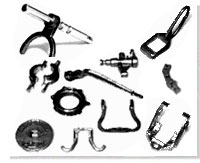Among precision methods for the production of cast metal components, permanent mold or mould (PM) casting stands out for cost and quality effectiveness. A reusable metallic mold is the conventional option for the process.
Where Permanent Mold Foundry is concerned, production of castings is mostly done by Conventional, Low Pressure, and Tilt Pour means. Like in the case of Sand Foundry, the emphasis is on inner integrity with flawless surface finish parts. The foundries have provision for cast-in inserts in permanent mold processes. Permanent Casting weight may vary from ounces to sixty pounds.
A Brief HistoryThe availability of Permanent Mold castings for copper alloys in North America's foundry industry dates back many years.
Of late there is widespread use of the Permanent Mold casting of copper alloys across Asia, Europe and United Kingdom. But in North America acceptance is rapidly increasing with engineers and designers becoming aware of its unique benefits.
Permanent Mold ProcessWhile various standard copper alloys are suitable for the Permanent Mold casting process, in metallurgical terms certain compositions are preferable. As with sand castings, casting properties of an alloy do matter. At the same time, many common sand casting alloys don't find favour with the permanent mold process.
For the current needs for near net shape castings, Permanent Mold casting makes a cost effective option with flexibility and design freedom. The process involves a metal casting die with metal or sand cores as required.
The basic casting process is given below:
- Production is preceded by preheating of the Metal Mold to achieve the requisite Mold temperature.
- Next comes assembling and closing of the Mold which may have two or more parts.
- Once it has solidified, the mold is opened and the casting removed. Reassembly of the mold follows and the process is repeated.
 (The steel cores at the top of the Mold are where the molten metal is poured with the steel cores being removed shortly).
(The steel cores at the top of the Mold are where the molten metal is poured with the steel cores being removed shortly).
As a casting method, Permanent Mold makes a suitable alternative for tools made from welded assemblies, sand castings, investment castings, forgings, and also for complicated configurations machined from the bar stock.
ClassificationsThe construction of permanent mold dies is done in sections whose functions are similar to the cope and drag in sand molds. Through clamping or hydraulic force the sections join together into a mold with the die cavity. For products of simple shapes, two die sections are enough but the more complex castings, particularly ones with re-entrant angles need multi-component dies.
The molten metal is added to the die cavity using sprues, runners and gating systems in the die sections. Air relief risers and overflow cavities may also be used. For internal structures in the finished castings, baked sand cores are fitted into the die cavities. By combining more than one die cavity into a single mold, productivity can be increased.
Conclusion The permanent mold casting can be described as a clean method with minimal waste and practically no fumes. Whatever scrap and excess metal emerges from gates and runners can be recycled to the furnace. Above all, the contamination problems facing sand foundries are virtually absent in the process.
The permanent mold casting can be described as a clean method with minimal waste and practically no fumes. Whatever scrap and excess metal emerges from gates and runners can be recycled to the furnace. Above all, the contamination problems facing sand foundries are virtually absent in the process.
Keeping permanent molds free of coating: A number of factors determine the methods and materials a foundry uses to remove coating from its permanent molds. These include volume of production, frequency of cleaning molds, casting complexity and environmental concerns. Casting quality, particularly casting surface finish and dimensional accuracy, is directly affected by the choice of method. Therefore it may be necessary for foundries to try different methods to identify the process that delivers the best results for a particular task.
